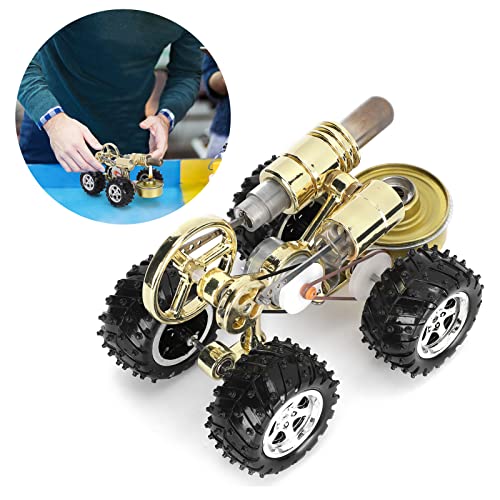Tony Bird
Senior Member
Hi,
When visiting a garden railway show earlier this year (2018), I bought a model steam locomotive chassis for £30. The seller said that it was made by Bowman and indeed it was, a Model 300 which in 1928 cost 18/6p (84/85p). The purchase consisted of a complete running chassis, footplate and burner; the means of holding the burner to the foot plate was missing. It wasn’t in too bad a condition most of the paint was missing and it was dirty with a bit of rust.
The first photograph is from Bowman’s 1930 catalogue where the price has increased to 21/-, a Guinea or one pound one shilling; our old monetary system was wonderful, everyone’s mental arithmetic has gone down hill since we went metric! It is just as well that there was no ‘Trade Description Act’ in place in 1930. The model is described as an 0-4-0 well it does have 4 wheels but if you want to be pedantic it is an 2-2-0 as only the rear axle is driven. Some of the claims in the text are also a bit optimistic; however, Bowman models were simple, inexpensive, robust if a bit variable regarding their manufacturing quality. The designs were for the most part was good which perhaps allowed them to work when somewhat out of manufacturing tolerances. (P001)

All of the Bowman designs of locomotives a very basic: only single acting cylinders are used which drive one axle only, there is no regulator the speed being controlled either by capping the burner tubes or varying the load, cylinder lubrication is by a felt pad mounted behind the piston. The chassis as bought dirty with the burner unattached. (P002).

Close up of the cylinders and leading axle. (P003).

A bit out of level? (P004).

Not being a collector and just wishing to run the model on either my portable layout or garden railway something would have to be done about the wheels. Though nominally the Bowman and my track are the same coarse scale gauge ‘0’ when the Bowman was made the points used had no check rails and the track was considerably higher than in use today. In consequence the back to back measurements of the wheel sets wasn’t important and the height of the wheel flanges impressive which helped the model stay on track at speed going around two-foot radius curves. My track requires a back to back measurement of 28 mm so it looks like the wheels will need new axles as well as re-profiling. (P005).

The chassis was checked running on air before taking it apart. It did run, albeit a little roughly at 15 psi. (P006).

The pistons and cylinders were removed from the chassis and the chassis along with the footplate and burner were put in caustic soda to remove the dirt and what remained of the paint. The cylinders were lapped and the piston and its rod cleaned up. With the chassis having been removed from the caustic soda and washed it was re-united with the cylinders and footplate and run on air again. It ran a lot smoother and at 8 psi, so, something had been achieved! (P007).

A means of securing the burner to the footplate was made and the chassis was run on air at a steam toy exhibition. (P008).

The next few months was taken up in finishing my garden railway. It was only a couple of days ago that looking to fill in time before going to our son’s place for Christmas was any further work done to the chassis. The footplate and burner were removed from the chassis. (P009

When the chassis was taken apart it was found that the leading wheels were screwed onto their axle and the driving axle wheels had a register that set the crank pins at 180 degrees to one another the wheels being held in place with nuts. There were no exhaust pipes the steam exiting the cylinders between the frames, the frames themselves were rivetted to their spacers. There was a lot of end play between the wheels and the frames some of which was taken up with some circles of bent iron wire spacers which might have been original, if original one had been replaced by a split washer. (P010).

Out of photograph space so I will continue in another post.
Regards Tony.
When visiting a garden railway show earlier this year (2018), I bought a model steam locomotive chassis for £30. The seller said that it was made by Bowman and indeed it was, a Model 300 which in 1928 cost 18/6p (84/85p). The purchase consisted of a complete running chassis, footplate and burner; the means of holding the burner to the foot plate was missing. It wasn’t in too bad a condition most of the paint was missing and it was dirty with a bit of rust.
The first photograph is from Bowman’s 1930 catalogue where the price has increased to 21/-, a Guinea or one pound one shilling; our old monetary system was wonderful, everyone’s mental arithmetic has gone down hill since we went metric! It is just as well that there was no ‘Trade Description Act’ in place in 1930. The model is described as an 0-4-0 well it does have 4 wheels but if you want to be pedantic it is an 2-2-0 as only the rear axle is driven. Some of the claims in the text are also a bit optimistic; however, Bowman models were simple, inexpensive, robust if a bit variable regarding their manufacturing quality. The designs were for the most part was good which perhaps allowed them to work when somewhat out of manufacturing tolerances. (P001)

All of the Bowman designs of locomotives a very basic: only single acting cylinders are used which drive one axle only, there is no regulator the speed being controlled either by capping the burner tubes or varying the load, cylinder lubrication is by a felt pad mounted behind the piston. The chassis as bought dirty with the burner unattached. (P002).

Close up of the cylinders and leading axle. (P003).

A bit out of level? (P004).

Not being a collector and just wishing to run the model on either my portable layout or garden railway something would have to be done about the wheels. Though nominally the Bowman and my track are the same coarse scale gauge ‘0’ when the Bowman was made the points used had no check rails and the track was considerably higher than in use today. In consequence the back to back measurements of the wheel sets wasn’t important and the height of the wheel flanges impressive which helped the model stay on track at speed going around two-foot radius curves. My track requires a back to back measurement of 28 mm so it looks like the wheels will need new axles as well as re-profiling. (P005).

The chassis was checked running on air before taking it apart. It did run, albeit a little roughly at 15 psi. (P006).

The pistons and cylinders were removed from the chassis and the chassis along with the footplate and burner were put in caustic soda to remove the dirt and what remained of the paint. The cylinders were lapped and the piston and its rod cleaned up. With the chassis having been removed from the caustic soda and washed it was re-united with the cylinders and footplate and run on air again. It ran a lot smoother and at 8 psi, so, something had been achieved! (P007).

A means of securing the burner to the footplate was made and the chassis was run on air at a steam toy exhibition. (P008).

The next few months was taken up in finishing my garden railway. It was only a couple of days ago that looking to fill in time before going to our son’s place for Christmas was any further work done to the chassis. The footplate and burner were removed from the chassis. (P009

When the chassis was taken apart it was found that the leading wheels were screwed onto their axle and the driving axle wheels had a register that set the crank pins at 180 degrees to one another the wheels being held in place with nuts. There were no exhaust pipes the steam exiting the cylinders between the frames, the frames themselves were rivetted to their spacers. There was a lot of end play between the wheels and the frames some of which was taken up with some circles of bent iron wire spacers which might have been original, if original one had been replaced by a split washer. (P010).

Out of photograph space so I will continue in another post.
Regards Tony.






















































![MeshMagic 3D Free 3D Modeling Software [Download]](https://m.media-amazon.com/images/I/B1U+p8ewjGS._SL500_.png)
















![DreamPlan Home Design and Landscaping Software Free for Windows [PC Download]](https://m.media-amazon.com/images/I/51kvZH2dVLL._SL500_.jpg)